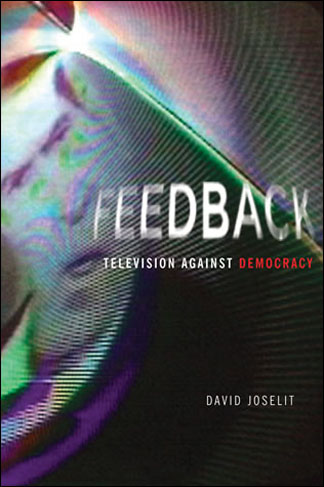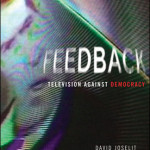By MARTINA TANGA
Media-America is a place where the consumer is alienated, without freedom of speech, and most importantly, without freedom of choice. David Joselit sets up and describes a dismal outlook on American consumer capitalist society. Democracy in this age, in this world, is a farce. Feedback is a stand against this order. In describing how artists have used visual medium, Feedback indicates how art history and visual culture might break free from this condition we have come to accept too comfortably and too passively.
The work’s major trope is its unique methodological approach to the analysis of American consumer culture, the history of television and video art. Joselit’s methodology is to set up a symbiotic relationship between two spheres and analyses them, one as the ground, and the other as the figure. This allows us to consider the two spheres outside their ordinary context; drawing out different sets of meanings and values. Moreover, both spheres are rendered instable allowing us to see where the relationship works and where instead, it collapses. It assays the crevices.
The most important relationship Joselit sets up in Feedback is between the history of television and the artistic production, specifically video art. One forms a grounding, or context, for the analysis of the other. In this case, the history of television in the Unites States functions as a ground against which art can be re-read, re-interpreted and seen anew. In this way we can see how images circulate and impact society. It is a way of investigating the ‘ecology’ of the image. This methodology is a rich tool allowing us to see, through art, where social political change is due and necessary.
What is achieved by looking at the history of television in the United States? Joselit sets up a circuitous argument whereby television, commodity and network, are locked into a single symbiotic system. It is paramount to delineate and explain the relationships that have come to exist between the television network, the commodity and the consumer, to sustain that television is anti-democratic. This is because, Joselit points out, the "commodification of audiences is not merely an aspect of consumption – it marks television’s transformation of democratic publics into statistically defined markets (…)" In other words, the commodification of the network, and ourselves, as consumer of those networks. The result of this roundabout of associations and commodification is that we, the society that partakes in the existence of Americanism, are trapped in this ‘closed circuit’ television consumer culture.
Against this ground, Joselit discusses how artists have challenged, attacked, broken into and rebelled against America’s ‘closed circuit’. He specifically looks at artists – here a term that encompasses the broadest definition – who work and operate on the edge of the American flush capitalist system, where they are agents through the links, associations, and connections they make, and the encounters they facilitate.
Joselit identifies three principal strategies these artists engage with. Firstly, the creation of art that acts as a virus: infiltrating the system and diseasing it. In this context Joselit discusses the work of Nam June Paik. Paik’s uses television as a catalyst that might help ‘correct’ or reform the entire economy. According to Paik, art is a more modest and more effective strategy than revolution or subversion. His aim is to consciously distort images from the television to infiltrate and disrupt the network system. A good example of this is Electronic Opera #1 from 1969.
A different approach to the same strategy, explored mainly on the west coast, is the hippie counter culture movement epitomized by artists such as Timothy Leary and the Diggers. They aimed to use television and the network from within to openly counter and criticize it. The premise was: if the commodity form has succeeded in structuring both politics and consciousness, then any effort to circumvent or destroy it must occur on the ground of commodity exchange. Therefore, television becomes possibly the only locus where subversion can occur.
However, Joselit’s example of this counter culture movement is not completely convincing to the overall argument because the factual result of their complete rejection of contemporary current culture by their extensive drug intake, was escapism. Tripping to an alternative reality detaches you from your present one. The ultimate result marred their reality disjointing plausible solutions to the issues at stake. Were the players of the counter culture movement not mere pawns in the greater scheme of things? A point left somewhat undeveloped.
Another strategy identified by Joselit is feedback: attacking the network giant with its own weapons. That is to say, as television is usually conceived in terms of the receiver, this strategy aims to form a symbiosis and feed back into television as much as they receive to render the system void and avoid commodification. Joselit surveys how certain personas have used television and the commercial model as a strategy for radical politics: assimilating the rhetoric of the very corporate structures that these personas were endeavored in challenging. Joselit specifically looks to Abbie Hoffman and the yuppie movement and Andy Warhol, possibly the most famous master of media manipulation for his own aspiration. However, here too the argument encounters a problem; namely, there is a price to pay with fame and celebrity status – the voiding of power of the message itself and its ability to be subversive – and therefore, ultimately being commodified.
The third strategy pinpointed is the avatar. Here, the crux is in the creation of a brand, an icon, an alter ego, that circulates throughout the network system. Characters are constructed and maintained through the television network. This is how politicians have made use of television media, and the network system, to their advantage. For example, Richard Nixon’s use of his own image, and the manipulation of that image within the media network, to express sincerity, power, and leadership. However, the result on the viewer is comparable, Joselit sustains, to brainwashing or worst, policing.
Joselit identifies how artists themselves have used the avatar to uncover and denude this farce. A prime example is Live-Taped Video Corridor by Bruce Nauman, which functions by heightening the viewer’s self awareness. Nauman and other artists, such as Antonio Acconci, Peter Campus, and Joan Jonas, using the video and television medium in the 1970s, call forth images of the consumer viewer, to produce avatars whose purpose is to navigate the media network, identifying the locus of politics and destabilizing the network world. In this way, art functions as a social agent.
It is interesting to note that the strategies identified by Joselit are named using an extremely contemporary vocabulary. Avatar, virus, feedback are all terms we use today in our lexicon of high paced media communications. In the 1960s, the focus of this study, these terms could not have been even conceived. Joselit applies today’s vocabulary to the then systems of operation. This bridges the generational gap and gives Feedback a sense of agency.
Overall Feedback is not only an organic exploration of television, its inception and its mid-century development into a tyrant, but also the first study to map the development of video art in relation to the emergence of television and the commodification of consumer society. However, the model is solely based on the American prototype. Further research and investigation should be made into how these systems operated in different countries. For example, the comparison between the American and European models, and how and in what way did television influence other practicing artists.
In addition, Feedback does not deal with contemporary artists. The issues in Feedback are still very real to our world today and possibly heightened by new and highly problematic means of communication and commercialization and therefore commodification, namely, the internet. The open ended question that begs to be asked, what are artists doing now in reaction to these new systems?
Feedback concludes with a Manifesto. It asks each and every one of us, through our practice, as artist, art historian, critic or civilian, to take a stand and be consciously aware of the power and uses of television. To end with Susan Sontag’s famous statement: take a stand against interpretation and in favor of action.
- Cover of Feedback: Television against Democracy by David Joselit, The MIT Press, Cambridge MA and London, England 2007, 1st Edition. 210 pages
- Bruce Nauman, installation of Live-Taped Video Corridor, 1970.
David Joselit is Professor in the Department of Art History at Yale University. Feedback Television against Democracy, was published by MIT Press in 2007.
All images are courtesy of the MIT Press and Media Art Net






